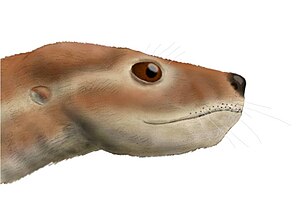Probainognathia
aus Wikipedia, der freien Enzyklopädie
| Probainognathia | ||||||||||||
|---|---|---|---|---|---|---|---|---|---|---|---|---|

Lumkuia | ||||||||||||
| Zeitliches Auftreten | ||||||||||||
| Untertrias bis Obertrias | ||||||||||||
| 245,9 bis 203,6 Mio. Jahre | ||||||||||||
| Fundorte | ||||||||||||
| ||||||||||||
| Systematik | ||||||||||||
| ||||||||||||
| Wissenschaftlicher Name | ||||||||||||
| Probainognathia | ||||||||||||
| Hopson, 1990 |
Die Probainognathia sind Landwirbeltiere aus der Gruppe der Therapsiden („säugetierähnliche Reptilien“). Sie lebten von der Unter- bis zur Obertrias.
Merkmale
[Bearbeiten | Quelltext bearbeiten]Die Probainognathia können nur wenige für die Gruppe typische Merkmale aufweisen. Hauptmerkmal ist der sich bildende sekundäre Gaumen. Stirnbein und Gaumenbein haben an der vorderen Knochenbegrenzung der Orbita Kontakt. Außerdem haben sie eine charakteristische Rippenmorphologie.
Systematik
[Bearbeiten | Quelltext bearbeiten]Die meisten Autoren unterteilen die Probainognathia in zwei Familien, die Probainognathidae, deren einzige Gattung Probainognathus ist und die Chiniquodontidae. Daneben gibt es zwei basale Gattungen, Ecteninion und Lumkuia.
- Ecteninion
- Lumkuia
- Probainognathus
- Chiniquodontidae
Chiniquodontidae
[Bearbeiten | Quelltext bearbeiten]Die Chiniquodontidae waren kleine bis mittelgroße Carnivoren. Das Schädelfenster war vergrößert und umfasste die halbe Schädellänge. Die Orbita ist durch eine schmale Postorbitalspange vom Schädelfenster getrennt. Der sekundäre Gaumen hat die Länge der Zahnreihe. Chiniquodontidae hatten 4 obere und drei untere Schneidezähne, mittellange Eckzähne und sieben seitlich abgeflachte Backenzähne.
Morphologisch sind die Chiniquodontidae konservativer als die Tritylodontidae und die Trithelodonta, lebten jedoch in der Mittleren Trias, während die fortschrittlicheren Cynodonten erst in der Obertrias erschienen.

Gattungen
[Bearbeiten | Quelltext bearbeiten]- Chiniquodon, Jugendstadien wurden als Belesodon und Probelesodon beschrieben.
- Dromatherium
- Microconodon
- Pseudotriconodon
Literatur
[Bearbeiten | Quelltext bearbeiten]- Thomas S. Kemp: The Origin & Evolution of Mammals. Oxford University Press, Oxford 2005. ISBN 0198507615.
- Robert L. Carroll: Paläontologie und Evolution der Wirbeltiere, Thieme, Stuttgart (1993), ISBN 3-13774-401-6
Text is available under the CC BY-SA 4.0 license; additional terms may apply.
Images, videos and audio are available under their respective licenses.
